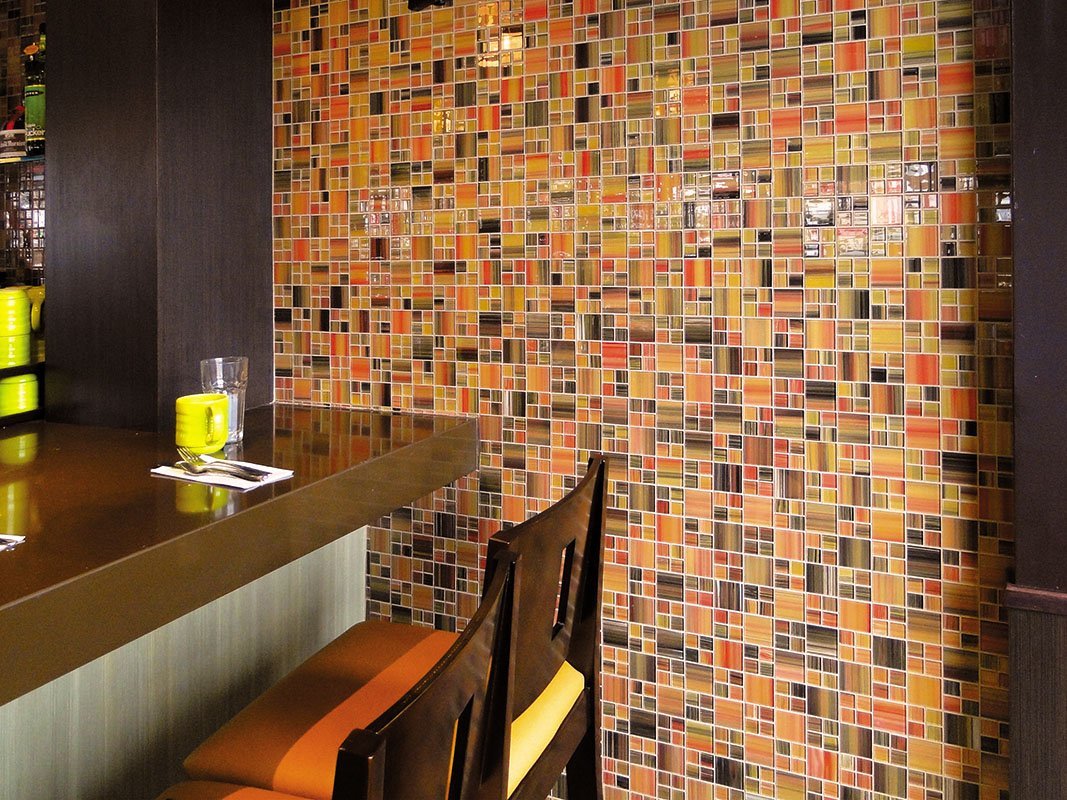Mosaic - is not just a kind of small masonry elements, and a way of expressing art. This type of decoration is one of the most decent places not only in art but also in everyday life. Mosaic pattern found in many of the interior of apartments and houses. Deciding to decorate their homes facing material initially is necessary to understand its diversity, the properties, to figure out how to glue the mosaic on the floor, wall or ceiling. Without this knowledge, it is simply impossible to choose the appropriate product to perform properly assembling their own hands, or to control the wizard.
Content
- product Features
- Types of mosaic - their advantages and disadvantages
- glass
- mirror
- stone
- Ceramic or glazed
- The choice of adhesive for mosaic tiles
- Floor technology
- The calculation of the amount of glue and mosaic
- Required tools and materials
- Preparing walls
- Apply the adhesive and laying mosaic
- Grouting - finishing
- conclusion
product Features
Mosaic art originated in ancient times. The first mosaics were found during excavations of the temples and palaces of Mesopotamia Sumerian cities. These buildings Historians refer to the second half of the 4th millennium BC. There are many finds relating to the ancient times, but the flowering of masonry fell on the era of the Byzantine Empire, where they began to use smaller stones processed.
Since the first prototype took place more than one thousand years, the mosaic is still a popular form of decoration. It is decorated with kitchens, bathrooms, toilets and other facilities. The construction market offers a wide range of mosaic tiles, with which to create a unique interior, spread original patterns on the walls, floor, ceiling.

One of the main features of the tiles can be called its dimensions. The size of individual elements is from 10 to 50 mm². Small units can be installed not only on flat surfaces, but also to use them for facing rounded shapes, eg columns, convex, concave surfaces. The square shape of the chips is most common, but there are also rectangular, circular, diamond-shaped, other pixels.
In the manufacture of finished products used a variety of materials. On sale you can find ceramic, glass, stone, metal, smaltovye, mirror, and even wood chips. The color palette of the finished product the most diverse. When selecting the most suitable shade is necessary to pay attention to the purpose of the room, the effect of color on the human psyche.

Types of mosaic - their advantages and disadvantages
Mosaic tiles has a number of significant advantages. It is of excellent appearance, resistant to moisture, temperature extremes, does not fade in the sun. With proper selection and installation will last for decades. Among the shortcomings can be identified high cost of the product. Also on the stacking small elements, the composition of the panel takes a lot of time.
High performance, the ability to create original designs allow the use of mosaic in different rooms. With it you can draw walls and floor in the bathroom, shower, and even oblitsevat pool. In the kitchen, most of it is used for the design of the kitchen apron countertop. This material can be decorated with niches, columns, decorated with a fireplace, and other architectural elements.

As noted above, for the production of mosaic tiles used a variety of materials. Each of them has its own characteristics. In order to understand the existing varieties, have a full understanding of the products in question, we will stop in more detail on the basic types.
See also:Wallpaper "city" in the interior: works of art on the walls





glass
Mosaic manufacture the small fraction of white sand. In the process of heating up to 1400 C and more it is transformed into liquid glass mass, which is bottled in standard form size of 10 to 50 mm². Glass many times stronger than usual, can be transparent, colored, frosted, decorated decoration. To give it a specific color in the liquid composition is added minerals.
Separately, you can select smalt. In fact, it is the glass produced by special smelting technology with the addition of metal oxides. There are several types of glazes: transparent, deaf, or opal, wiry and spotted, gold and silver. If the first three subspecies obtained by addition of the dyes and choke the substances, the manufacture of the last foil is used.

Advantages plates:
- durability;
- easy maintenance;
- ecological purity of the material;
- inertness to the mold and mildew;
- attractive design;
- heat resistance;
- impact resistance;
- water resistance;
- frost.
Disadvantages:
- high price;
- sophisticated styling;
- fragility;
- slippery surface.

mirror
Mosaic is a kind of glass. There are options such as a grid attached to and sold in bulk. For the mirror effect on the backside of the wafer is applied or sprayed amalgam (reflection coating of silver and mercury). As usual glass, this kind of tile has the same advantages, but also allows to visually enlarge the room, filling it with light, hide the surface roughness.

Under the influence of moisture, bases, other organic solvents reflective layer may tarnish, darken that it requires additional protection. The coating can be damaged and as a result of mechanical influences, so stacking plates should produce professionals. Particular attention should be paid to the glue. It is recommended to choose a non-aqueous compositions in white, do not give shrinkage during solidification.





stone
Stone - unique natural material, which has the original coloring, pattern, pattern. There are several classifications of stone tiles, but the most popular is based on the breed:
- Precious and semi-precious. Diamonds, rubies, emeralds, spinel, other. Rarely used, mainly for decoration of vases, boxes and other small items.
- Ornamental. Serpentine, malachite, jasper, agate, and other species with bright colors and distinctive patterns.
- Finishing. Marble, granite, basalt. The most popular breeds have an affordable price.
- Simple (savage). Pebbles, sandstone, travertine.
- Artificial. The underlying ceramic, produced by high temperature molding powder.
The main advantages of the material can be distinguished its durability, so once inlaid panels will last for decades. Stone is not afraid of deformation, resistant to abrasion, resistant to mechanical stress, unpretentious in the care. It is characterized by a variety of shapes, colors. But, despite all its advantages, the cells are heavy and expensive.

Ceramic or glazed
Among the huge variety of materials used in the decoration, mosaic among the most practical and popular. Using smaller particles may create an entire picture. In fact, it's the same ceramic tile, but in a reduced form. Small plates fully retain all the properties of the tile, respectively, have virtually identical characteristics and operational features.
The main advantages of this material include:
- High strength. Mosaic tile is resistant to abrasion, is not afraid to stress, mechanical damage. Unlike conventional tiles, in contact with the surface of a heavy object does not break.
- Low slipperiness. Due to the large number of stitches, it does not slip even in contact with water surface.
- Attractive appearance. It characterized by a wide range of colors, a variety of sizes and shapes.
- Stability to moisture, temperature extremes.
- Heat resistance.
- Simple cleaning. Suffice it to periodically wet cleaning the surface with a sponge.
See also:Wallpaper design in a flat 75 photo examples in the interior walls

Among the shortcomings is possible to allocate a higher value than the standard tiles. Mosaic more demanding on the plane on which it is placed, it requires careful preparation. Grout used much more grout. Time for stacking small elements is substantially increased.





The choice of adhesive for mosaic tiles
Bonding mosaic easily carried by hand. Regardless of the installation site and the selected technology, necessary quality training base, the correct selection of adhesive. You can put a mosaic on any adhesive suitable for tiles. But when choosing a particular type of mixture it is necessary to take into account the state of the surface and its features. For gluing the mosaic elements often used the following materials:
- Cementitious adhesive. It has the lowest price compared to other formulations. Manufacturers produce white or gray mixture, packed in bags of 20-30 kg. It consists of cement, sand, gypsum, alabaster, fillers and plasticizers. Cement glue diluted with water or liquid latex, is used for application to the brick, concrete masonry.
- Dispersion composition. It sold ready-made in banks. The composition includes water, mineral components, acrylic additive. Pasty cement is more expensive, but the convenience of its application compensates for this drawback. To complete solidification takes 30 minutes. During this time, you can adjust the position of the mosaic tiles. The residue mixture may be permanently stored in a sealed package.
- Two-component adhesive. The composition includes a high weight epoxy resin and hardener. A material suitable for adhering to smooth surfaces mosaic (marble, glass, plastic, metal). Mosaic cladding via two-component mixtures is carried out in a bathtub, swimming pool, kitchen, shower room.

Floor technology
Stick mosaic self can only be pre-aligned base. To conceal irregularities putty used with reinforcing mesh or paper layer. On the computation of artistic ornament could only manage a professional. Calculate the correct distance between the small details very difficult. Novice masters during installation is best to use a special mosaic canvas with pre-fixed pattern.

The calculation of the amount of glue and mosaic
With self-repair carrying out many novice master buy tile adhesive without preliminary calculation of its amount. As a result, the material has to re-buy or dispose of residues. Glue consumption depends on several factors - the type, the size of the tile, paving equipment, qualification of the master.
To find out how much will need to glue on 1 m2You can use several ways to count. The easiest - use the automatic calculator. In certain fields you must enter the characteristics of materials, the number and wait for the displayed results. Despite the ease of use and efficiency, the method is not reliable, because the calculations are approximate.
Once defined design facing material, you can proceed to the calculation of its amount. If the tiles square, a simple formula can be used. First, you need to measure the effective surface area. Then, determine the area of the tile element. Now, based on the size divided by the size of one piece and get the required number of units.
Calculation mixture styling is performed with regard to the type of facing material. For easy enough tiles 2-10 mm thickness. The heavier ceramics better mounted on the mixture layer laid 15-20 mm. To increase this rate is possible if installation is done on the surface with considerable irregularities.
If the recommended thickness of the adhesive inflate the solution, the mixture will be long to dry. When the vertical wall covering all or part of the elements may move.

Required tools and materials
Mosaic originally adhered to a special module in the form of a mesh or a sheet of paper. Composite web is then be easily transferred to any surface. It can be cut with scissors or a knife, give any form. For laying mosaic pieces will need the following materials and tools:
- Primer. To finish the bathroom or kitchen required waterproof agent;
- Glue for a special type of mosaics and the surface;
- Grout;
- Notched trowel to apply adhesive mass;
- Plate for leveling the surface;
- Rubber blade for grouting;
- Sandpaper grinding;
- Any rag for removal of consumables.
See also:Mirror tiles in the interior: the idea of the application

Preparing walls
The most common base in the form of cement-sand screed. Less common area for the installation of plastic trim or plasterboard. Regardless of the option selected requires careful preparation of the walls. The surface should be smooth, without cracks and dents.
During the preparation necessary to clean the wall of dust and dirt. Then wash the walls and applied primer. If they are covered with plasterboard, it is necessary to seal the seams and cover cap screws. When the dry coating adhesion improver can begin stacking.

Apply the adhesive and laying mosaic
To hold the mosaic module on a vertical surface it is important to bring the adhesive to the desired consistency. The mixture was applied to a simple spatula type spackling, from the corner. When will be ready the surface for several paintings, it should once again pass the toothed plate. Direction of the stroke in this case does not matter. Excess solution is transferred to an adjacent wall portion.
There are two types of mosaic substrate - paper base and netted. Each method is fundamentally different elements stickers. In the first case parts leans against the glue mixture, and the paper is left outside. In the second - a grid with a fixed mosaic laid on the adhesive.

Grouting - finishing
It is not enough high-quality grout can easily spoil the appearance of the mosaic. To avoid this, before the application of color or white mixture to be cleaned tiled surface from dust, remove the adhesive from the joints begin to flow.
Grout can be cement or epoxy. When choosing to be guided by individual factors. Should take into account operating conditions mosaic, probable physical load, chemical and thermal influences. You should also take into account the depth and the width of the seam. Grout should be adjusted to match the mosaic, or be a bit darker.
Pointing joints only after complete drying of the glued mosaics. It will take at least 24 hours. If this rule is not observed, the spots may appear on the treated area.

conclusion
mosaic cladding ideal for rooms with high humidity. Unusual, effective solution to complement any interior. With a variety of colors, materials and textures, this type of trim is becoming universal. Mosaic is easy to paste on the surface of any type, even on curved and convex. After watching a video tutorial or photos, the work can handle even the novice step by step wizard.


